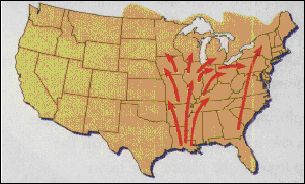During the past several weeks, significant leafhopper damage has been observed in a few nurseries within central NJ counties. Although there are many species of leafhoppers, the Potato Leafhopper (Empoasca fabae) is probably the most notorious in the northeastern U.S. states. The feeding damage can mimic herbicide injury with distortion & discoloration of foliage. Some of the common deciduous tree hosts include maple, oak, ash, & birch as well as others. The Potato Leafhopper does not overwinter in NJ, but during the weeks of May is carried-in by upper atmospheric winds from the gulf coast states .
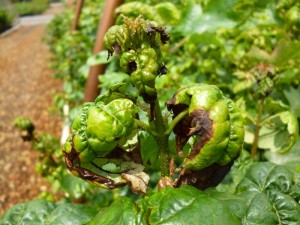
Potato Leafhopper & “hopperburn” symptoms on Acer rubrum at a Burlington County Nursery Photo Credit: Steven K. Rettke of RCE
When symptoms at branch terminals become apparent, inspect leaf undersides for adults or nymphs. Leafhoppers move with a side-ways or lateral motion & this walking behavior is generally diagnostic for leafhopper species. These insects have piecing-sucking mouthparts & when feeding some release a toxin that restricts movement within vascular tissues. The characteristic “hopperburn” can cause a progression of symptoms on foliage that range from a light bronze discoloration to a dark brown or almost black appearance. Leaf symptoms can mimic drought stress and will be even more pronounced if a drought is actually occurring.
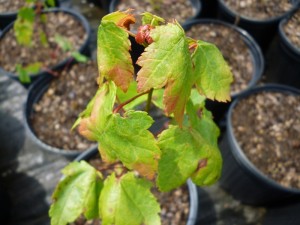
Potato Leafhopper symptoms with wedge-shaped discoloration to Acer rubrum at a Monmouth County Nursery Photo Credit: Steven K Rettke of RCE
The inserted photographs show some of the common “hopperburn” symptoms which include browning & necrosis along leaf margins & also the leaf curling, stunting, and distinctive V-shaped wedge discolorations (initially brown or yellow). As leafhoppers insert their stylets to probe into phloem or xylem leaf tissue they can cause a disorganization of vascular bundles & produce an enlargement & proliferation of cells. This can create symptoms of a “witches-broom” effect on rapidly growing terminal stems.
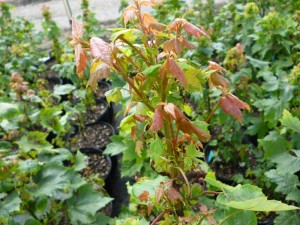
Potato Leafhopper feeding & “Witches-Broom” effect on Acer rubrum at a Burlington County Nursery Photo Credit: Steven K. Rettke of RCE
As some species of leafhoppers feed they can transmit bacteria within their saliva into vascular tissue which then may produce a wound response by the plant. This can result in a blockage in vascular transport and cause severe scorch-like symptoms on trees such as red maple, oak, elm & red mulberry. Other feeding symptoms as shown in the photograph below on Quercus morilandica produce a curious corrugated appearance to the foliage.
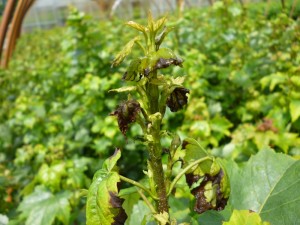
Potato Leafhopper feeding & severe scorch-like symptoms on Acer rubrum at a Ocean County Nursery Photo Credit: Steven K. Rettke of RCE
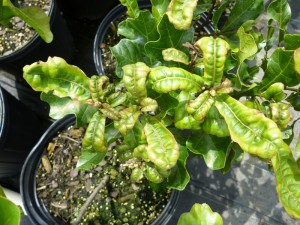
Potato Leafhopper feeding symptoms on Quercus marilandica at a Burlington County Nursery Photo Credit: Steven K. Rettke of RCE
In New Jersey, the Potato Leafhopper (PLH) typically has 4 or 5 generations per year. There are 5 nymphal instar stages during each generation. As we now reach the end of July, the nymphs of the 3rd generation may be evident in many parts of the state. In August, the 4th generation may become active followed by the 5th & final generation in September. Eggs are laid in the midrib of upper foliage on host plants during each successive generation. However, PLH eggs will not survive our cold winter temperatures & hence new generations in the spring must blow-in from the southern gulf states.
Chemical treatments targeting the initial late spring & early summer generations should help reduce the population levels of later generations (unless untreated populations from nearby, adjacent areas continue to blow-in). Many treatment options are effective. One successful strategy has been the use of a pyrethroid for quick knockdown combined with a systemic neonicotinoid for longer residual controls.

